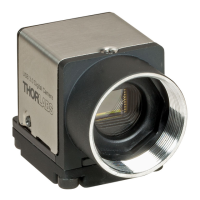© 2013 Thorlabs GmbH48
DCx Cameras
Flash timing with global shutter sensor, automatic flash,
optional trigger delay
Flash timing with rolling shutter sensor, automatic flash,
optional trigger delay
Manual flash synchronization
If one of the flash delay or flash duration parameters is set to a value greater than 0, you can shift the flash signal
to any point in the exposure time or change its duration. In this case, the flash delay will be calculated exactly from
the start of the exposure time (after the sensor latency time). When manually synchronizing the flash signal to the
exposure time, you can use the is_IO() function to query the data you need.
The advantage of manual flash synchronization is that the flash can be precisely controlled based on the start of
exposure. This applies to both rolling and global shutter sensors. You can thus achieve a higher accuracy with the
manual flash synchronization than with the automatic flash feature.
The disadvantage is that the flash signal has to be resynchronized whenever any settings for image geometry or
camera timing change.
Note
With rolling shutter sensors, you can avoid the rolling shutter effect by selecting suitable delay and duration
settings (global flash function). Using is_IO() , you can query the appropriate values.
Note
The flash output is reset with the start of the next image capture. This also applies if you have set a longer flash
duration.
280
31
280

